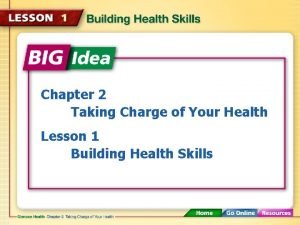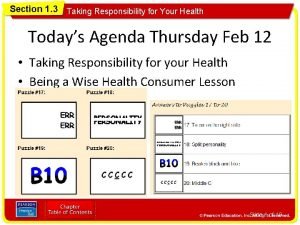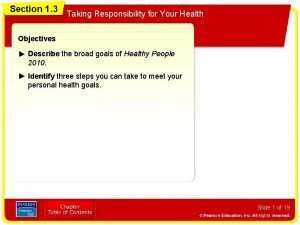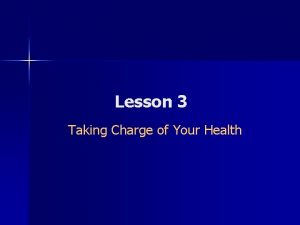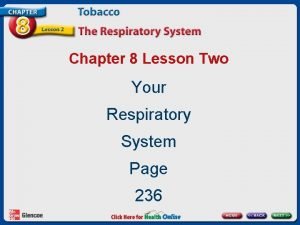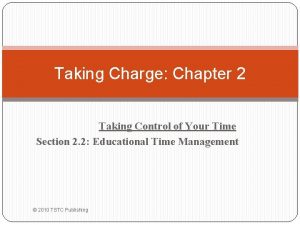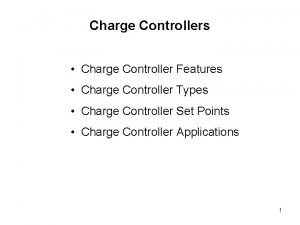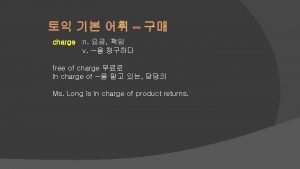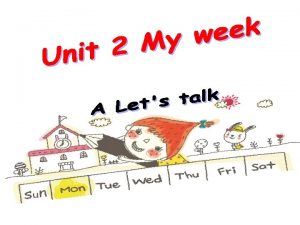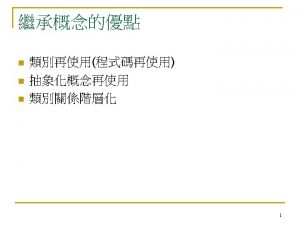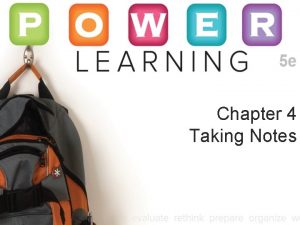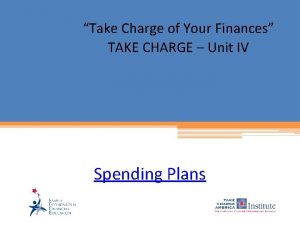Taking Charge of Your Class Taking Charge of






















- Slides: 22

Taking Charge of Your Class; Taking Charge of your Teaching Global Education Sector Office of Overseas Programming & Training Support (OPATS)

Common Teacher Complaints n n n I have to teach the book. I don’t like the book. I have to teach to the test. The test is very traditional. The students aren’t serious. They don’t appreciate me. 2

Many Teachers Feel They Have No Control n n But you (and your counterpart) CAN control much of what takes place in the classroom And when you decide the main elements of teaching you truly value, you can structure the culture of your class emphasize those values. 3

Good News! Classrooms are perceived as artificial constructs by everyone! For example, unlike the real world, in classrooms students can-n Make mistakes n Learn in a supportive atmosphere n Get an explanation it before we try it n Receive learning support n Get (kind, helpful) feedback Therefore you have flexibility in structuring your class! 4

TAKING CHARGE! • • STEP 1: Create Your Classroom Culture STEP 2: Learn to see and bridge your performance GAPS 5

Performance Gap: The gap between the teacher’s beliefs and values about teaching and what the teacher is actually doing in the classroom. 6

For example, many teachers. . . Actually. . Who want to. . n are teacher centered n be student centered n do “chalk & talk” n address learning styles n punish mistakes n use mistakes to learn n manage through respect discipline & threats and trust n assign vaguely n provide meaningful related exercises practice pulled from texts at 7 hand

The Observed Teacher Quandary If an experienced teacher walked into your classroom unannounced and could observe without being disruptive, what kind of teacher would she think she was seeing? What values and beliefs would she assume that you had? Would her assumptions match yours? 8

Mapping Teaching Values & Beliefs to Practices Practice Values/Beliefs n Student centeredness n n Manage class well n n Support learning n Get to know students; design ways for different students to participate Be well-organized and consistent; emphasize and praise good behavior over punishing bad Teach less, provide more practice, review at the end of the class, the next class and at the end of the week. Test as you taught. 9

Why do you think that teachers often become the very kind of teacher that they did not want to be? Suggestions: n n n Teaching is more complex that they thought. Alone in a classroom, they seek to protect themselves Preparation takes time and they run out of ideas Seeking to demonstrate their knowledge (& worth), they deliver too much information and too little practice Student respect and trust can be hard to earn and learning is often more difficult than teachers had imagined. 10

How do we close the performance gap? 1, Reflect on teaching values and beliefs to determine— n how their teaching values and beliefs will play out in making classroom decisions 2. Talk with counterpart teachers--make a list of common classroom practices and routines. Then reflect on-- (a) what motivates them and (b) to what extent they match or conflict with your teaching values and beliefs, and how you will resolve any “expectations gaps. 11

Closing Performance Gaps How to look for them!

Examine Values and Beliefs n n n What are your teaching values and beliefs? What are some typical expectations your students or counterparts might bring to class? How could you bridge the gap between yours and theirs? 13

Consider Practices, Routines, & Behaviors What rules are conventional in your country? What rules do you want YOUR classroom have? What behaviors are associated with good (and bad) students? Do they match your ideas? What kinds of clothing, haircuts, school equipment do you expect? How will you show you are competent and organized AND kind and flexible? What behavioral habits do you have that might be misunderstood in your host school culture? 14

Look to Learner Training (Socialization) for Ideas How do students catch on to the behaviors and conventions that successful learners engage in? n n How much of it is explicit and official? How much of it comes from hints and tips as student implicitly “learn the ropes? ” n How much of it might come from simple observation? n How can you learn the ropes of your school culture? 15

Examine Expectations about Classroom Roles n n What relationships do you want between you and your students? How much power? How close? What will your students and counterparts expect of teacher/student relationship? How should students see interactions with each other? What’s polite behavior toward whom? 16

Practice 1: n Take 15 minutes to work with a partner so that each of you reflect on one possible gap each of you might find between: 1. 2. n Your teaching values and beliefs and what you may actually be doing in the classroom. The values and beliefs you chose and those of your local school culture. Share your “gap” with your partner for five minutes. Together brainstorm ways to help bridge each other’s gap. 17

Balancing Teacher Values and Beliefs with School or Student Expectations. n The following are sample conflicts that Peace Corps TEFL teachers can sometimes encounter in West African classrooms. How would you respond to the situation in a way that balances your teaching values and beliefs with local expectations? 18

1. 2. 3. 4. 5. When a student is late, can s/he enter? If not, where does s/he go? Stand at the window, go to the office, leave school? When a student answers a question should they stand up, raise their hand? What if the norm is to stand up and the PCV does not require them to stand because the PCV feels uncomfortable, does this reduce the teacher's credibility? If a student looks at his neighbor's paper during an exam, is that cheating? If they do cheat, do you give them a zero or only half marks? If a student misses a test can they take it in a later date? What if you don’t know if they were sick or if they skipped class? If a student needs to go out to the bathroom, will you let him? Will you have a “going to the bathroom routine and policy? If so, what will they be? 19

Practice 2 n Work 10 minutes to discuss one of the situations mentioned in the previous slide. Think about: What factors do you need to consider to develop an effective policy and rules that meet local norms and don’t violate your personal teaching values and beliefs? n Is there only one reasonable response? You might need to try alternatives. Can you think of at least one? 20

APPLICATION: Putting Teaching Values and Beliefs into Practice Teaching Value or Belief Classroom Practice (Example) Students learn and retain longer when the lesson connects to their personal experience. Start lessons by helping students discover what they already know about the lessons, then ask them to think about what else they would like to know about it. (which is known as the K-W-L method) 21 21

Thanks for your attention and thanks for respecting your students! 22
 Taking charge of your health chapter 2
Taking charge of your health chapter 2 Taking charge of your health chapter 2
Taking charge of your health chapter 2 Taking charge of your health chapter 1
Taking charge of your health chapter 1 Destiny 2 taking charge
Destiny 2 taking charge The illusion of taking charge
The illusion of taking charge Give us your hungry your tired your poor
Give us your hungry your tired your poor Difference between charge and electric charge
Difference between charge and electric charge Difference between charge and electric charge
Difference between charge and electric charge Your health is your responsibility
Your health is your responsibility Taking responsibility for your health quiz
Taking responsibility for your health quiz Lesson 3 taking responsibility for your health
Lesson 3 taking responsibility for your health Taking care of your respiratory system
Taking care of your respiratory system Lesson 3 taking responsibility for your health
Lesson 3 taking responsibility for your health Formula of charge
Formula of charge Potential due to point charge class 12
Potential due to point charge class 12 Todaysclass
Todaysclass Package mypackage class first class body
Package mypackage class first class body Difference between abstract class and concrete class
Difference between abstract class and concrete class What is the lower boundary of the modal class
What is the lower boundary of the modal class Class i vs class ii mhc
Class i vs class ii mhc Abstract concrete class relationship
Abstract concrete class relationship Median class
Median class Stimulus
Stimulus
